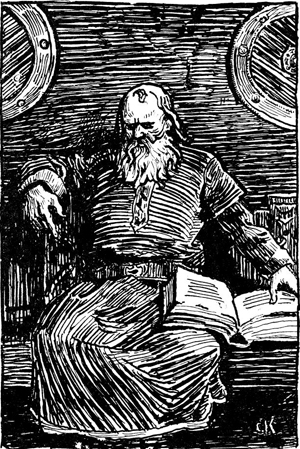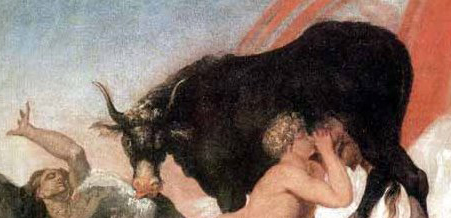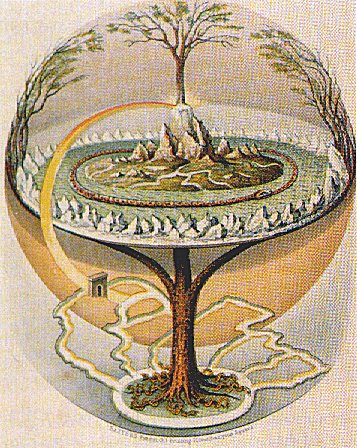September Lesson
Welcome to this class, Norse Myths and Legends! For those of you not familiar with the Norse Mythology, here is a short introduction to the subject. After this introduction, the rest of the lesson content of the class will be myths and legends only, so please forgive me for having you read through facts first!
Introduction to Norse Mythology
Norse Mythology was the heathen beliefs of people living in Scandinavia in the pre-Christian time, approximately between the 2nd to 11th centuries. These countries include Sweden, Norway, Denmark, Iceland and the Faroe islands. The vikings also brought their beliefs to areas they invaded and occupied, like parts of Britain, Germany and Greenland. People didn’t view their beliefs like a religion, but rather as traditions and a way of living, so they didn’t have a name for it. The traditions and legends were passed on from generation to generation for many centuries before the first written records appeared. Christianity spread through Scandinavia starting around the 11th century and the old heathen beliefs were more or less lost. There are however many myths that were preserved in Norse folklore as late as the 19th century.
Most existing records of the Norse myths date from the 11th to 18th centuries. Since the legends had been around for a long time before that, all written records need to be read with a critical eye (as is the case with all old written sources which have been preceeded by oral traditions). Three of the more important sources are the Prose (Younger) Edda, the Heimskringla and the Poetic (Elder) Edda.
Snorri Sturluson (1179-1241) was a poet, historian and politician from Iceland. He is famous for writing the Prose Edda and the Heimskringla. The Prose Edda was supposedly written around the year 1220 and the reason why he wrote it was to explain and preserve the old way of writing and telling poetry. At the same time he collected a lot of old myths and preserved them for the future. The Heimskringla, supposedly written around the year 1230, is a history of the Norwegian kings, starting with the legends of the Swedish dynasty of the Ynglings and moving through early medieval history and the historic Norwegian kings until the year 1177. It is the best known of the sagas of the Old Norse kings.

The Poetic Edda is a collection of Old Norse poems and no one knows who wrote them down for the first time. The source of the poems, Codex Regius, has probably been written by several different collectors and writers. This particular source has been dated to around the year 1270, but there are spelling errors and other indications that the texts are older than that, and that Codex Regius is only a handwritten copy of an older source. It is also highly likely that the stories and poems themselves were several hundred years old when they were written down, passed on from generation to generation. Most of the poems and verses in the Poetic Edda are stories about the gods. Characteristic for the verses and poems of the Poetic Edda is that most of them are written in the form of a dialogue or a monologue. Many poems are educational or moralizing, others are dramatizations of adventures of the gods, goddesses and heroes.
Enough of the facts! On to the myths!
The Creation Myth
There exist a few variations of this myth, and this is one version.
Long ago before the world was created, there was only Niflheim in the north – consisting of ice, frost and fog – the home of the shadow-beings; Muspelheim in the south – consisting of fire – the home of the fire-demons; and the empty void Ginnungagap between them. Poisonous water from the well Hvergelmer in Niflheim flowed into Ginnungagap where it froze in the shape of a giant man. Heat and sparks from Muspelheim eventually reached him and slowly made him melt and come alive. This was Ymir, the ancestor of all giants. While Ymir was still asleep he was sweating, and the result was that a man and a woman were born from his left armpit and a six-headed man was born from his legs. These three were the first giants.
The cow Audhumla was also created from the melting ice in Ginnungagap. She fed Ymir, and Audhumla herself fed on salty stones. She licked one stone for three days, and on the third day a man emerged. This was Buri, the first god. Buri had the son Borr with a giantess. Borr’s wife was the giantess Bestla, and together they had the sons Odin (the first of the Aesir gods), Vili and Ve.
Odin and his brothers killed Ymir, and almost all giants drowned in his blood. Only Bergelmir and his wife survived and the new generation of giants ascend from this couple. From the day of Ymir’s murder, there was an undying hatred and ongoing war between giants and gods.
The body of Ymir was used by Odin, Vili and Ve to create the Earth. His blood became oceans, lakes and rivers; his bones and teeth became mountains and rocks; his hair became trees and other plants; his skull became the heavens; and his brains became the clouds. From the dead body of Ymir the dwarves were born, and they lived underground or in big rocks. Four dwarves (North, South, East and West) were placed at the four corners of the Earth to hold up the heavens.
Odin and his brothers took sparks from Muspelheim and put them as stars in the heavens. The sun was guided by the young woman Sol (“sun”) and hunted across the sky by the wolf Skoll. The moon was guided by Sol’s brother Mane (“moon”) and hunted across the sky by the wolf Hati. And the woman Natt (“night”) drove her cart pulled by the horse Rimfaxe across the sky during night, and the morning dew was froth from his bridle; her son Dag (“day”) drove his cart pulled by the horse Skinfaxe across the sky during day, and his mane was shining brightly.
One day, Odin and his brothers found two nice-looking logs. The ash tree became the first human man, Ask (“ash tree”) and the elm tree became the first human woman, Embla (uncertain meaning, but might derive from “elm tree”). Odin gave them life and spirit. Vili gave them movement, mind and intelligence. Ve gave them shape, speech, feelings and the five senses.

The World Tree and World Order of Norse Mythology
There are nine different worlds in Norse Mythology.
Niflheim
Home of the shadow-beings, and of the dragon or serpent Nidhogg who was always chewing on the roots of the world tree Yggdrasil.
Muspelheim
Home of the fire-demons and ruled by the fire-giant Surt who guarded the border with his sword of fire.
Jotunheim
Home of the giants (jotun means giant), situated by the big ocean surrounding the world. The giants are enemies of gods and humans; violent creatures but wise and not altogether evil.
Godheim
Home of the gods, situated in the middle of the world. The gods created Asgard where the Aesir (the main group of gods) dwelled. From Godheim to Mannheim they built the bridge Bifrost (the rainbow) but humans and giants could not cross it, only gods.
Vanaheim
Home of the Vanir, a group of gods who are contemporary with the Aesir. Some Vanir lived in Asgard after the Aesir-Vanir war.
Mannheim
Home of the humans, situated between Jotunheim and Godheim. The gods created the fortress Midgard from Ymir’s eyebrows to protect the humans from the giants.
Alfheim
Home of the Light-Elves (something between gods and humans) and ruled by the Vanir Frey.
Svartalfheim
Home of the dwarves (sometimes called Black-Elves), moody creatures who are the best blacksmiths in all the worlds.
Helheim
The death realm, situated in the underworld somewhere in Niflheim and ruled by the death goddess Hel. The entrance to Helheim was guarded by the dog Garm.
All of these worlds are connected by the world tree Yggdrasil. Its roots reach into Niflheim, Jotunheim and Godheim. An eagle sits in the top of the tree, the dragon/serpent Nidhogg chews on its roots, and the squirrel Ratatosk runs up and down the tree with messages between them. Other creatures also live in Yggdrasil, like a falcon, and four deer eating from its branches.

Sources:
Stora boken om vikingarnas gudar och myter by Lars Magnar Enoksen (ISBN 978-91-7738-792-3)
Nordiska gudar och hjältar by Anders Baeksted (ISBN 91-37-09184-0)